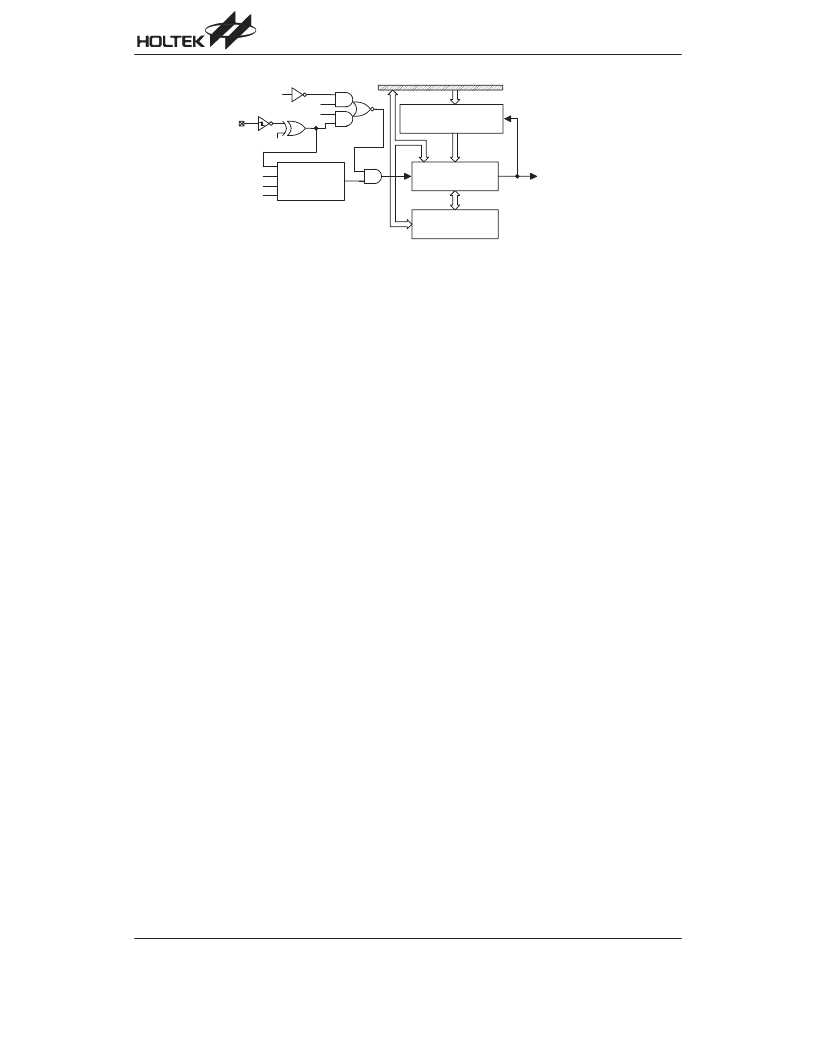- 您現(xiàn)在的位置:買賣IC網(wǎng) > PDF目錄385405 > HT86192 (Holtek Semiconductor Inc.) Voice Synthesizer 8-Bit MCU PDF資料下載
參數(shù)資料
| 型號: | HT86192 |
| 廠商: | Holtek Semiconductor Inc. |
| 英文描述: | Voice Synthesizer 8-Bit MCU |
| 中文描述: | 語音合成器8位微控制器 |
| 文件頁數(shù): | 26/39頁 |
| 文件大小: | 368K |
| 代理商: | HT86192 |
第1頁第2頁第3頁第4頁第5頁第6頁第7頁第8頁第9頁第10頁第11頁第12頁第13頁第14頁第15頁第16頁第17頁第18頁第19頁第20頁第21頁第22頁第23頁第24頁第25頁當(dāng)前第26頁第27頁第28頁第29頁第30頁第31頁第32頁第33頁第34頁第35頁第36頁第37頁第38頁第39頁

HT86XXX
Rev. 1.70
26
May 6, 2004
The TMR0C is the Timer/Event Counter 0 control regis-
ter, which defines the Timer/Event Counter 0 options.
The Timer/Event Counter 1 has the same options as the
Timer/Event Counter 0 and is defined by TMR1C.
The timer/event counter control registers define the op-
erating mode, counting enable or disable and active
edge.
The TM0, TM1 bits define the operating mode. The
event count mode is used to count external events,
which implies that the clock source comes from an ex-
ternal (TMR0/TMR1 is connected to PC4/PC5) pin. The
timer mode functions as a normal timer with the clock
source coming from the instruction clock. The pulse
width measurement mode can be used to count the high
or low level duration of an external signal
(TMR0/TMR1). The counting method is based on the in-
struction clock.
In the event count or timer mode, once the timer/event
counter starts counting, it will count from the current
contents in the timer/event counter to FFFFH. Once an
overflow occurs, the counter is reloaded from the
timer/event counter preload register and generates a
corresponding interrupt request flag (T0F/T1F; bit 5/6 of
INTC) at the same time.
InthepulsewidthmeasurementmodewiththeTONand
TE bits equal to one, once the TMR0/TMR1 has re-
ceived a transient from low to high (or high to low; if the
TE bit is 0) it will start counting until the TMR0/TMR1 re-
turns to the original level and resets TON. The mea-
suredresultwillremaininthetimer/eventcounterevenif
the activated transient occurs again. In other words,
only one cycle measurement can be done. When TON
is set again, the cycle measurement will function again
as long as it receives further transient pulses. Note that,
in this operating mode, the timer/event counter starts
counting not according to the logic level but according to
the transient edges. In the case of counter overflows,
the counter is reloaded from the timer/event counter
preload register and issues the interrupt request just like
in the other two modes.
To enable the counting operation, the Timer ON bit
(TON; bit 4 of TMR0C/TMR1C) should be set to 1. In the
pulse width measurement mode, TON will be cleared
automatically after the measurement cycle is complete.
But in the other two modes TON can only be reset by in-
struction. The overflow of the timer/event counter is one
of the wake-up sources. No matter what the operation
mode is, writing a 0 to ET0I/ET1I can disable the corre-
sponding interrupt service.
In the case of a Timer/Event Counter OFF condition,
writing data to the timer/event counter preload register
will also reload that data to the timer/event counter. But
if the timer/event counter is turned on, data written to the
timer/event counter will only be kept in the timer/event
counter preload register. The timer/event counter will
continue to operate until an overflow occurs.
When the timer/event counter (reading TMR0H/
TMR1H) is read, the clock will be blocked to avoid er-
rors. As this may result in a counting error, this must be
taken into consideration by the programmer.
Timer Counter 2
The timer counter TMR2 is also a 16-bit programmable
count-up counter. It operates in the same manner as
Timer/Event Counter 0/1, but the clock source of TMR2
is from only internal instruction cycle (T1). Therefore
only (TM1,TM0)=(1,0) is allowable.
"
'
-
> ) *
-
' ,
$
'
-
)
C
'
' )
-
'
)
C
' )
#
B ' 3 "
3
% %
' 3
-
C
% - B
'
Timer/Event Counter 0/1
相關(guān)PDF資料 |
PDF描述 |
|---|---|
| HT86384 | Voice Synthesizer 8-Bit MCU |
| HT86576 | Voice Synthesizer 8-Bit MCU |
| HT86R192 | Voice Synthesizer 8-Bit OTP MCU |
| HT86R384 | Voice Synthesizer 8-Bit OTP MCU |
| HT86XXX | 8-Bit Voice Synthesizer MCU |
相關(guān)代理商/技術(shù)參數(shù) |
參數(shù)描述 |
|---|---|
| HT86192(68PLCC) | 制造商:未知廠家 制造商全稱:未知廠家 功能描述:Microcontroller |
| HT86384 | 制造商:HOLTEK 制造商全稱:Holtek Semiconductor Inc 功能描述:Voice Synthesizer 8-Bit MCU |
| HT86384(68PLCC) | 制造商:未知廠家 制造商全稱:未知廠家 功能描述:Microcontroller |
| HT8650 | 制造商:未知廠家 制造商全稱:未知廠家 功能描述:IC-MESSAGE REMINDER IC |
| HT8650(28DIP) | 制造商:未知廠家 制造商全稱:未知廠家 功能描述:Speech Synthesizer |
發(fā)布緊急采購,3分鐘左右您將得到回復(fù)。